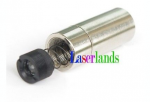Hi everyone,
I've got these diode housings and I'm not sure what kind of metal they're made of (the description just says metal). I'm guessing it might be iron or steel though I'm not sure. Does anyone have any ideas?

Anyway I was wondering if there was a rule of thumb of choosing a housing material to go with a certain powered diode. For example what powers can be safely used in a housing made of iron/steel, and at what point would I need a copper housing to safely dissipate the heat? Like if I had a 445nm 1.6W Sharp GH04C01A2G diode would that burn up in an iron/steel housing?
Thanks
I've got these diode housings and I'm not sure what kind of metal they're made of (the description just says metal). I'm guessing it might be iron or steel though I'm not sure. Does anyone have any ideas?

Anyway I was wondering if there was a rule of thumb of choosing a housing material to go with a certain powered diode. For example what powers can be safely used in a housing made of iron/steel, and at what point would I need a copper housing to safely dissipate the heat? Like if I had a 445nm 1.6W Sharp GH04C01A2G diode would that burn up in an iron/steel housing?
Thanks



